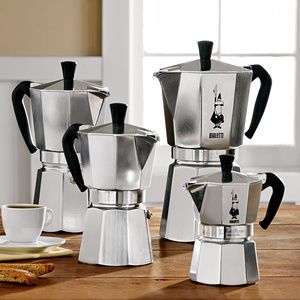Coffee training pot Bilodi Bialetti mocha pot

The earliest method of brewing coffee was to boil coffee powder directly in water on the stove and filter it for drinking. In the 19th century, people began to try to use steam to brew coffee, hoping to make a strong cup of coffee in a very short time. At the beginning of the 20th century, the industrial revolution began to ferment all over the world, and the italians built an espresso machine that looked and sounded like a steam train boiler. The dazzling metal case had brass accessories, and the coffee was brewed with sound and light effects. Steam trains were an epoch-making product, allowing people to travel quickly from one place to another, and they didn't disappoint when they were used to brew coffee. Modern feelings and coffee tastes were perfectly combined. Coffee shops attracted Italian men like magnets, and there was always a good excuse to leave home.
Coffee at home pales in comparison to coffee in cafes. This situation did not change completely until 1933 when Alfonso Bialetti invented the first appliance to completely improve home coffee. And this coffee appliance is the mocha pot we are familiar with today. What is even more amazing is that this mocha pot has never changed at any point since Bialetti was designed. Whether it is material design or even appearance, what we see today is exactly the same as the first mocha pot born in 1933. Its distinctive shape even ranked among the most influential Italian designs of the 20th century, alongside the Vespa in 1946 and the Fiat 500 in 1957.
The clever Bialetti created a mocha pot that allowed people to brew coffee-house coffee at home, but the octagonal mocha pot didn't really flourish until his son Renato inherited the mantle.
Renato returned to Italy from Germany after World War II and reopened the machinery his father packed during the war. With his marketing skills, he expanded from reading newspapers, broadcasting and even large-scale three-dimensional sculptures outside exhibition halls. The production of Moka Express expanded from 10,000 bottles per year in his father's time to 1,000 bottles per day, and the global sales volume reached 300 million bottles from 1950 to the end of the 20th century.
Times are changing, and the material of mocha pots has evolved from aluminum to a variety of materials, but Bialetti's Moka Express mocha pot, in addition to some parts produced by industrial technology, still insists on the hand-made bottom pot used to hold water since its inception in 1933, which is why its internal surface looks very handmade. The original Italian Bialetti mocha pot has a cartoon image of a mustached man pointing up as if he is ordering a cup of coffee. This is a logo created by Renato in accordance with his father's image. It now appears in 90% of Italian families, but also in the hearts of coffee lovers all over the world.
Important Notice :
前街咖啡 FrontStreet Coffee has moved to new addredd:
FrontStreet Coffee Address: 315,Donghua East Road,GuangZhou
Tel:020 38364473
- Prev

Coffee training knowledge on how to choose fresh coffee beans
Coffee training knowledge: how to choose fresh coffee beans? Freshness is the life of coffee, how to determine the freshness of coffee beans? There are three steps: smell, see, and peel. Smell: put the coffee beans close to the nose and smell them deeply to see if you can clearly smell the aroma of the coffee beans. If so, the coffee beans are fresh enough. On the contrary, if the aroma is weak, or the oil has begun to appear.
- Next

Coffee training pot Bilodi Bialetti mocha pot
The earliest way to cook coffee is to directly boil the coffee powder with water on the stove and filter it to drink. Since the 19th century, some people have tried to use steam to brew coffee, hoping to make a strong cup of coffee in a very short time. At the beginning of the 20th century, the industrial revolution began to ferment around the world, and the Italians created a shape and momentum that resembled a steam train boiler and a general espresso coffee machine.
Related
- Beginners will see the "Coffee pull flower" guide!
- What is the difference between ice blog purified milk and ordinary milk coffee?
- Why is the Philippines the largest producer of crops in Liberia?
- For coffee extraction, should the fine powder be retained?
- How does extracted espresso fill pressed powder? How much strength does it take to press the powder?
- How to make jasmine cold extract coffee? Is the jasmine + latte good?
- Will this little toy really make the coffee taste better? How does Lily Drip affect coffee extraction?
- Will the action of slapping the filter cup also affect coffee extraction?
- What's the difference between powder-to-water ratio and powder-to-liquid ratio?
- What is the Ethiopian local species? What does it have to do with Heirloom native species?

